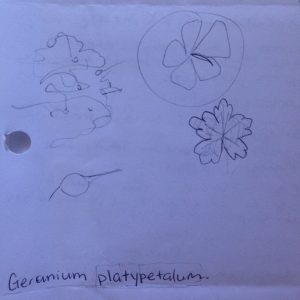
http://www.spieringandco.com/uploads/media/pg5.jpg
Class summary: Perennial geranium, part of the Geraniaceae family. Contributes to a good ground cover – forming a thicket, suppressing annual weeds. In addition, produces continual blooming flowers (through succession) with broad, large petals. Cranebill is attributed to the crane-like pod before the flower blooms. Horizontal leaves. Needs irrigation and will produce more flowers and foilage if left in light shade. Softens path edge. Deep purple flowers.
Sites conditions: Sunny with partial shade or shelter. Likes, moist, well-drained soil but do not over water. They grow to .5 to 1m. Ground cover, border. Cold resistant and winter hardy.

http://1b2kqn1ngt5a333t0b3w4ikz.wpengine.netdna-cdn.com/wp-content/uploads/2015/06/holt_780_0537.jpg

http://www.gapphotos.com/images/LargeWebPreview/0537/0537465.jpg
http://herbaceousplants.homestead.com/Geranium_macrorrhizum_up_to_trunk.JPG
Aesthetics: It is a ground cover that offers more of a robust feel than a creeper (geranium or blue star). Possess a fuller body and flowers are bright – The deep purple hue saturates the eye with colour. The purple/magenta colour could potentially be paired with other bright flowering plants. What I enjoy about perennial geraniums, are their alternate/crooked like branches, that slightly tilt the flowers, creating spontaneity from the uniform leaves. The smell of geraniums are paramount in my favour of them. The mounding form with a slight wild texture could potentially look good under high branching trees or paired with rocks or taller perennials such as an ornamental onion.
Notes: Great source of nectar for bees, butterflies, hummingbirds, moths, flies, bubble-bees.
Cultivars:
G. platypetalum ‘Genyell’

https://s-media-cache-ak0.pinimg.com/236x/1f/bc/8b/1fbc8bcf8d50590af3d02e015a0fcc10.jpg

